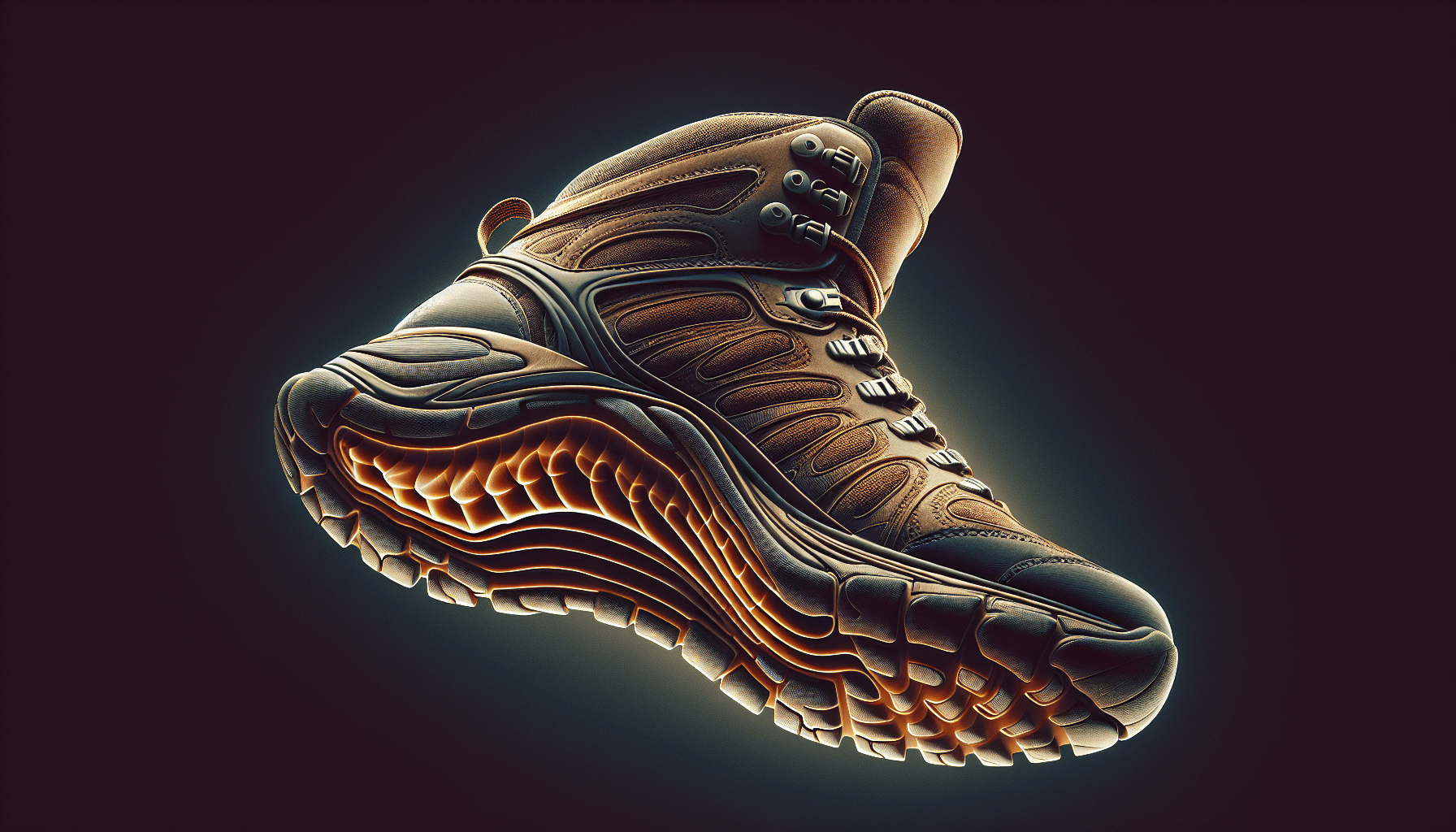Are you someone with flat feet who loves hiking? If so, finding the right pair of hiking boots can make all the difference in your comfort and enjoyment on the trails. In this article, we will explore the key features that you should look for in hiking boots specifically designed for flat feet. Whether you’re a seasoned hiker or just starting out, understanding these features will help you choose the perfect pair of boots that provide optimal support and stability for your feet. So let’s get started on your quest for the ideal hiking boots tailored for flat feet!
Arch Support
Cushioned and contoured footbed
When it comes to hiking boots for flat feet, arch support is crucial. Look for boots with a cushioned and contoured footbed that is designed to provide optimal support to the arch of your foot. The cushioning helps absorb the impact of each step, reducing discomfort and pain. Meanwhile, the contoured shape follows the natural curve of your arch, promoting proper alignment and preventing overpronation.
Orthotic-friendly design
Having flat feet often means needing extra support, and wearing custom orthotics can help with that. To accommodate orthotics, opt for hiking boots with an orthotic-friendly design. These boots usually come with removable insoles, allowing you to replace them with your own orthotics. This customizable feature ensures that your flat feet get the necessary support and comfort throughout your hiking adventures.
Removable insoles
Even if you don’t wear orthotics, having the option to remove and replace the insoles in your hiking boots can be beneficial. This feature allows you to add or switch insoles to ones that better suit your needs. For instance, you might prefer insoles with more cushioning or arch support. Being able to customize the insoles can significantly enhance the comfort and support provided by your hiking boots.
Wide Toe Box
Provides enough room for toes to spread out
One common issue faced by individuals with flat feet is the overcrowding of the toes inside the shoes. A pair of hiking boots with a wide toe box can alleviate this problem by providing enough room for your toes to spread out naturally. This not only enhances comfort but also reduces the likelihood of discomfort and pain caused by cramped toes during long hikes.
Prevents discomfort and pain
When your toes are cramped, it can lead to discomfort and pain, especially for those with flat feet. A wide toe box in hiking boots can prevent this by allowing your toes to move freely and naturally. This not only reduces the risk of developing blisters or calluses but also prevents conditions like bunions or hammertoes. So, when choosing hiking boots for flat feet, prioritize those with a wide toe box to ensure comfort and minimize foot issues.
Firm Midsole
Offers stability and support for flat arches
One of the main support features to consider when selecting hiking boots for flat feet is the firmness of the midsole. A firm midsole provides the stability and support that individuals with flat arches need. It helps distribute the weight evenly across the foot, preventing excessive rolling of the foot inward (overpronation). The firmness of the midsole ensures that your feet are properly supported, reducing strain and discomfort during hikes.
Reduces overpronation
Overpronation, or the excessive inward rolling of the foot, is a common issue faced by those with flat feet. This can lead to an improper gait and an increased risk of injuries. By choosing hiking boots with a firm midsole, you can help reduce overpronation. The stability and support offered by a firm midsole encourage a more neutral foot position, ensuring a more balanced and comfortable hiking experience for individuals with flat arches.
Ankle Support
High-cut design
For individuals with flat feet, ankle support is crucial to maintain stability and prevent injuries while hiking. Look for hiking boots with a high-cut design that covers the ankle area. This design provides additional support and protection to the ankles, reducing the risk of sprains or twists. The high-cut design keeps your ankles secure and stable, allowing you to tackle various terrains with confidence.
Padded collar and tongue
To enhance the comfort and support around the ankle area, opt for hiking boots with a padded collar and tongue. The padding adds extra cushioning, reducing the pressure and friction on your ankles and preventing chafing or discomfort. Additionally, the padding also helps to secure the boots snugly around your ankles, further enhancing stability and support.
Lace-up closure for secure fit
To ensure proper ankle support, it’s essential to have a secure fit around the ankle area. Look for hiking boots that feature a lace-up closure system. This allows you to adjust the tightness of the boots according to your preference and the needs of your flat feet. The lace-up closure ensures that your boots stay securely in place, providing the necessary support to your ankles while preventing any unwanted movement.
Lightweight Construction
Lessens strain on flat feet
Hiking can be physically demanding, and carrying the weight of heavy boots on flat feet can increase fatigue and strain. Opting for hiking boots with a lightweight construction can alleviate this issue. Lightweight boots lessen the strain on your flat feet, making your hiking experience more comfortable and enjoyable. With less weight to carry, you’ll be able to go the extra mile without feeling excessively tired.
Increases comfort during long hikes
Long hikes require footwear that does not weigh you down or cause discomfort. Lightweight hiking boots are designed to provide the necessary support and protection without sacrificing comfort. Their construction materials and design elements contribute to a lighter overall weight, allowing your feet to move more freely. The increased comfort provided by lightweight hiking boots ensures that you can venture into longer hikes without feeling weighed down or fatigued.
Breathable Materials
Allows air circulation
Keeping your feet cool and dry during hikes is essential, especially for individuals with flat feet who are more prone to sweating. Choosing hiking boots made from breathable materials can greatly improve the comfort of your feet. Breathable materials, such as mesh or perforated fabrics, allow air circulation inside the boots, preventing excessive sweating and moisture buildup. This helps to keep your feet dry, reducing the risk of blisters and odor.
Reduces sweating and odor
Sweaty feet can lead to discomfort, chafing, and unpleasant odors. By selecting hiking boots with breathable materials, you can significantly reduce sweating and the accompanying issues. The increased airflow inside the boots allows moisture to evaporate more efficiently, keeping your feet dry and minimizing the development of odor-causing bacteria. This keeps your feet fresh and comfortable, even during extended hikes.
Traction and Grip
Rugged outsole with deep lugs
Walking on various terrains requires excellent traction and grip to prevent slips and falls. Look for hiking boots with a rugged outsole that features deep lugs. Deep lugs are the grooves on the outsole that provide traction by gripping onto the ground. A rugged outsole with deep lugs ensures that your boots maintain a firm grip on different surfaces, such as rocky trails or muddy paths. This enhances your stability and reduces the risk of accidents or injuries.
Provides stability on various terrains
For individuals with flat feet, maintaining stability is particularly important during hikes. The traction and grip provided by hiking boots with a rugged outsole contribute to this stability. By offering reliable traction, these boots allow you to navigate challenging terrains with confidence. Whether you’re hiking on slippery slopes or uneven trails, a pair of hiking boots with excellent traction and grip ensures a secure footing, preventing slips and falls.
Waterproofing
Keeps feet dry in wet conditions
Hiking often involves encounters with wet conditions like rain, puddles, or streams. Therefore, having waterproof hiking boots is advantageous, especially for those with flat feet. Waterproofing keeps your feet dry and protected, even when walking through wet environments. It prevents water from seeping into your boots, saving you from the discomfort of wet feet and potential issues like blisters or fungal infections. When choosing hiking boots, opt for ones with reliable waterproofing features for added convenience and comfort.
Durability
Long-lasting materials and construction
Investing in durable hiking boots is essential, regardless of foot type. However, for individuals with flat feet, the need for durability is even more significant. Look for boots made from high-quality materials and constructed with sturdy techniques. Durable hiking boots are built to withstand the demands of rugged terrains and long hikes, providing lasting support and protection to your flat feet. By choosing durable boots, you can rely on them to accompany you on many adventures without prematurely wearing out.
Proper Sizing and Fit
Accurate measuring and sizing
To ensure that your hiking boots provide optimal support and comfort, proper sizing and fit are crucial. Take the time to accurately measure your feet and refer to the brand’s size chart for guidance. Everyone’s feet can vary in shape and size, so finding the right fit is essential. Avoid squeezing into boots that are too small or allowing excessive space in boots that are too big. Opt for a size that allows your feet to move naturally while still providing a snug fit for stability and support.
Room for custom orthotics or additional support
Individuals with flat feet often benefit from custom orthotics or additional support devices. When selecting hiking boots, make sure there is enough room inside to accommodate these inserts comfortably. Having adequate space allows you to enhance the support and comfort of your boots according to your specific needs. Look for wider options or boots with removable insoles that can make room for orthotics or additional support devices. Prioritizing proper sizing and fit ensures that your hiking boots work harmoniously with the specific requirements of your flat feet.
By considering these features when choosing hiking boots for flat feet, you can find a pair that offers the optimal combination of support, comfort, and durability. Remember to prioritize arch support, wide toe boxes, firm midsoles, ankle support, lightweight construction, breathable materials, traction and grip, waterproofing, durability, and proper sizing and fit. Having hiking boots that address the needs of your flat feet will enhance your hiking experience, allowing you to explore the great outdoors with confidence and comfort.

